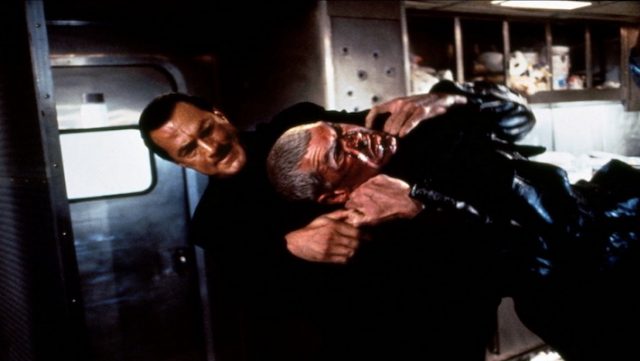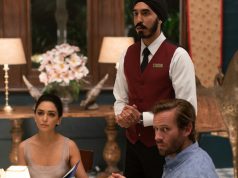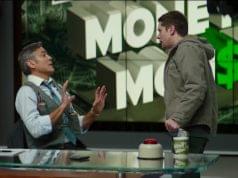
After Steven Seagal’s first movie, “Above the Law,” was a hit, he quite reasonably assumed he could continue to make the same film over and over again without anyone getting tired of it. Even the titles stayed basically the same: “Above the Law” was followed by “Hard to Kill,” “Marked for Death,” and “Out for Justice.” Yet despite his box-office success, the whisper-voiced, squinty-eyed Michigander was unable to win over movie critics, who see too many movies to still be amused by taciturn violence-mongers who recite punny one-liners after shooting bad guys.
So for his fifth film, Seagal tried something new and extraordinary. Instead of giving it a generic, vaguely threatening three-word title, he gave it a generic, vaguely threatening TWO-word title: “Under Siege.” It was risky, but the gambit paid off. The film was a success with audiences and critics alike. Many called it the finest performance of Seagal’s career, which was like declaring a particular handful of oatmeal less bland and lumpy than the others.
When the next film, “On Deadly Ground,” flopped financially and critically, Seagal hurriedly returned to his moment of glory and made a sequel to “Under Siege.” It was called “Under Siege 2: Dark Territory,” and while it was as stupid and laughable as his other movies, at least it had the words “Under Siege” in the title. You have to admit that the logic is impeccable (because if you don’t admit it Steven Seagal will kick your face off).
“Under Siege” took place on a U.S. Navy battleship that was beset by mercenaries seeking to steal its nuclear missiles. Seagal’s character, Casey Ryback, was a former Navy SEAL and all-around butt-kicker who now worked in the battleship’s kitchen, where he also excelled, and for some reason it became his job to stop the terrorists. For the sequel, they figured it wouldn’t be plausible for Casey to be on another battleship that got taken over by bad guys — that’s really a once-in-a-lifetime sort of thing — so “Under Siege 2” has him on a train that is taken over by bad guys, which happens all the time, which is why no one ever rides trains anymore.
Casey is on the train with his niece, Sarah, played by 17-year-old Katherine Heigl, who wasn’t famous yet but had already developed her beloved “humorless shrew” persona. (Between her and Seagal, “Under Siege 2” is jam-packed with stone-faced party-poopers. You could bring in Ben Stein and liven up the place.) Casey and Sarah are traveling from Denver to Los Angeles so that Sarah can visit the graves of her parents, who died recently. Conveniently, they died in a plane crash, giving Casey and Sarah a good reason to be traveling by train. Otherwise, “Under Siege 2” would have been about an airplane hijacking, and those are BORING.
No sooner are they aboard the train than Sarah is accosted by Bobby (Morris Chestnut), a motormouthed porter who thinks she is beautiful and wants to make sexytimes with her, respectfully. She declines by showing him one of the self-defense moves she learned from her dad, who was also a Navy SEAL. Bobby is further chastened by Uncle Casey. Then, for some reason, Casey goes into the dining car’s kitchen and makes a cake, like he owns the place. In his daily life, Casey is both a popular chef in Denver and a specially trained killing machine who performs secret missions for the U.S. Navy, so perhaps in this instance he has conflated his two purposes and declared martial law on the train’s kitchen. The point is, Casey is awesome at everything he does, 100 percent of the time, including cake-making.
Then some bad guys board the train and take over. Why a train? Hoo-boy, you’re opening a can of worms there. Give me a second. OK, so the Department of Defense recently launched a spy satellite that is also a weapon, but shh, don’t tell anyone, because that part’s a secret. We saw it launched at the beginning of the movie, and some DOD personnel commented on how it’s too bad someone named “Dane” wasn’t here to see it, because he was one of its chief engineers, and it’s so sad that Dane is dead now, having recently driven his car into a lake, and it’s so sad that they never found his body, and OK, whoever he is, Dane is obviously still alive. Sure enough, Dane (Eric Bogosian) faked his death (I don’t know why) and is now leading the siege on the train. He’s going to hack into the satellite he designed, demonstrate its weapon capabilities by using it to shoot lasers at the Pentagon (or something), and then sell control of it to terrorists.
But why a train? Oh, because he has to keep his satellite-hacking device in constant motion to prevent the DOD from tracing it and finding him, and trains are famous for going several hours without stopping. It’s sort of their “thing.”
(Note: The train in this movie stops several times.)
Back at government headquarters, they are pretty alarmed to see their secret weapon being remote-controlled by a guy they thought was dead. Actually, they’re surprised to see it being remote-controlled at all, let alone by a dead person. It gets worse when the top brass shows up and learns that not only is this unauthorized deadly technology fully functional, but it has already fallen into the wrong hands. The most devastating new weaponry always falls into the wrong hands eventually, but this has got to be a record. It was barely out of the box!
Meanwhile, Casey is not going to stand for his new favorite cake-making train being taken by mercenaries. Luckily, he has an Apple Newton, which in 1995 was the very height of futuristic space-age technology, in that you could type a message on it and fax it to someone, provided that person could receive faxes, and provided you had a phone line to connect your Apple Newton to. It’s the rare piece of machinery that is of interest to Casey yet cannot kill anyone. He sends a fax to his restaurant in Denver to alert the authorities, then takes matters into his own hands, which is to say he kills every bad guy on the train.
Oh, I’ve collapsed some of the events, sure, and Bobby the porter helps out a little, but it really boils down to Casey shooting, stabbing, exploding, or crippling every villain he can get his hands on. And when Dane and his men — all ex-military guns-for-hire — learn that the legendary Casey Ryback is onboard, they practically soil themselves in terror. Hijacking a train and shooting lasers from space at the Pentagon is no job for sissies, but come on. It’s CASEY RYBACK! Everyone is afraid of Casey, always, in all situations. (Like all covert-ops secret agents, Casey is very, very famous.)
Two people in the film refer to Casey as a “hero,” even before he has done anything heroic. In two other instances, a scene ends with someone saying the word “hero,” and the next scene starts with a shot of Casey, thereby sending the message that Casey=hero. This is a pattern with Steven Seagal movies. They showcase Seagal doing customary heroic things like snapping bad guys’ necks and running faster than explosions, but they’re still afraid we won’t get the message, so they also have the characters tell us over and over again that Seagal is a hero. Really, though, we get it! You kill a man in the dining car and then say, in front of no one but the camera, “Nobody beats me in the kitchen,” you’re a hero! We understand how that works. But Seagal movies keep telling us anyway. They’re not films so much as affirmations. I picture Seagal alone, in his darkened basement, playing his movies on an old film projector, Norma Desmond-style, and whispering softly, “Yes, I am a hero. I am a hero.” It’s sad, if you think about it, which is why I keep thinking about it.
— Film.com





